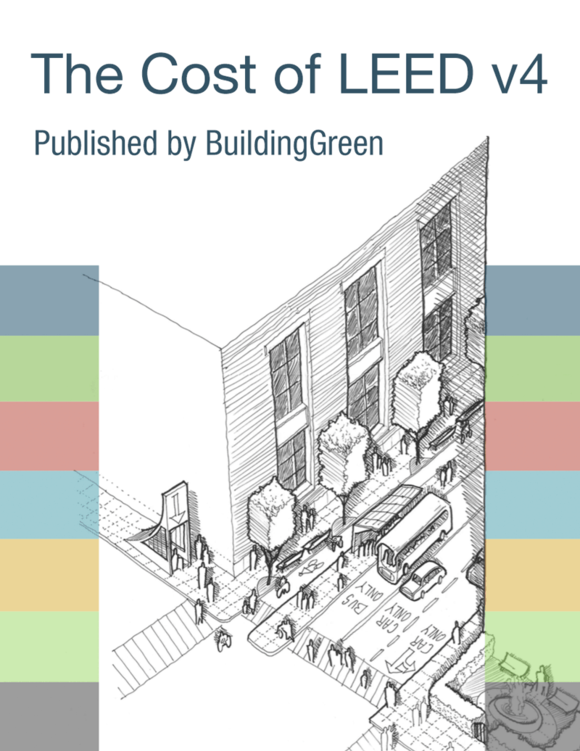Requirements
Option 1. No Refrigerants or Low-Impact Refrigerants (1 point)
Do not use refrigerants, or use only refrigerants (naturally occurring or synthetic) that have an ozone depletion potential (
ODP) of zero and a global warming potential (
GWP) of less than 50.
OR
Option 2. Calculation of Refrigerant Impact (1 point)
Select refrigerants that are used in heating, ventilating, air-conditioning, and refrigeration (HVAC&R) equipment to minimize or eliminate the emission of compounds that contribute to ozone depletion and climate change. The combination of all new and existing
base building and tenant HVAC&R equipment that serve the project must comply with the following formula:
IP units
LCGWP |
+ |
LCODP |
x |
105 |
≤ |
100 |
|
SI units
|
Calculation definitions for
LCGWP + LCODP x 105 ≤ 100
(IP units) |
Calculation definitions for
LCGWP + LCODP x 105 ≤ 13
(SI units) |
LCODP = [ODPr x (Lr x Life +Mr) x Rc]/Life |
LCODP = [ODPr x (Lr x Life +Mr) x Rc]/Life |
LCGWP = [GWPr x (Lr x Life +Mr) x Rc]/Life |
LCGWP = [GWPr x (Lr x Life +Mr) x Rc]/Life |
LCODP: Lifecycle Ozone Depletion Potential
(lb CFC 11/Ton-Year) |
LCODP: Lifecycle Ozone Depletion Potential
(kg CFC 11/(kW/year)) |
LCGWP: Lifecycle Direct Global Warming Potential
(lb CO2/Ton-Year) |
LCGWP: Lifecycle Direct Global Warming Potential
(kg CO2/kW-year) |
GWPr: Global Warming Potential of Refrigerant
(0 to 12,000 lb CO2/lbr) |
GWPr: Global Warming Potential of Refrigerant
(0 to 12,000 kg CO2/kg r) |
ODPr: Ozone Depletion Potential of Refrigerant
(0 to 0.2 lb CFC 11/lbr) |
ODPr: Ozone Depletion Potential of Refrigerant
(0 to 0.2 kg CFC 11/kg r) |
Lr: Refrigerant Leakage Rate
(2.0%) |
Lr: Refrigerant Leakage Rate
(2.0%) |
Mr: End-of-life Refrigerant Loss
(10%) |
Mr: End-of-life Refrigerant Loss
(10%) |
Rc: Refrigerant Charge
(0.5 to 5.0 lbs of refrigerant per ton of gross AHRI rated cooling capacity) |
Rc: Refrigerant Charge
(0.065 to 0.65 kg of refrigerant per kW of AHRI rated or Eurovent Certified cooling capacity) |
Life: Equipment Life
(10 years; default based on equipment type, unless otherwise demonstrated) |
Life: Equipment Life
(10 years; default based on equipment type, unless otherwise demonstrated) |
For multiple types of equipment, calculate a weighted average of all
base building HVAC&R equipment, using the following formula:
IP units |
|
SI units |
∑ ( LCGWP + LCODP x 105 ) x Qunit |
≤ 100 |
∑ ( LCGWP + LCODP x 105 ) x Qunit |
≤ 13 |
Qtotal |
Qtotal |
Calculation definitions for
[ ∑ (LCGWP + LCODP x 105) x Qunit ] / Qtotal ≤ 100
|
Calculation definitions for
[ ∑ (LCGWP + LCODP x 105) x Qunit ] / Qtotal ≤ 13
|
| (IP units) |
(SI units) |
Qunit = Gross AHRI rated cooling capacity of an individual HVAC or refrigeration unit (Tons) |
Qunit = Eurovent Certified cooling capacity of an individual HVAC or refrigeration unit (kW) |
Qtotal = Total gross AHRI rated cooling capacity of all HVAC or refrigeration |
Qtotal = Total Eurovent Certified cooling capacity of all HVAC or refrigeration (kW) |
Retail
Meet Option 1 or 2 for all HVAC systems.
Stores with commercial refrigeration systems must comply with the following.
- Use only non-ozone-depleting refrigerants.
- Achieve an average HFC refrigerant charge of no more than 1.75 pounds of refrigerant per 1,000 Btu/h (2.72 kilograms of refrigerant per kW) total evaporator cooling load.
- Achieve a store-wide annual refrigerant emissions rate of no more than 15%.
Alternatively, stores with commercial refrigeration systems may provide proof of attainment of EPA GreenChill’s silver-level store certification for fully operational food retail stores.


